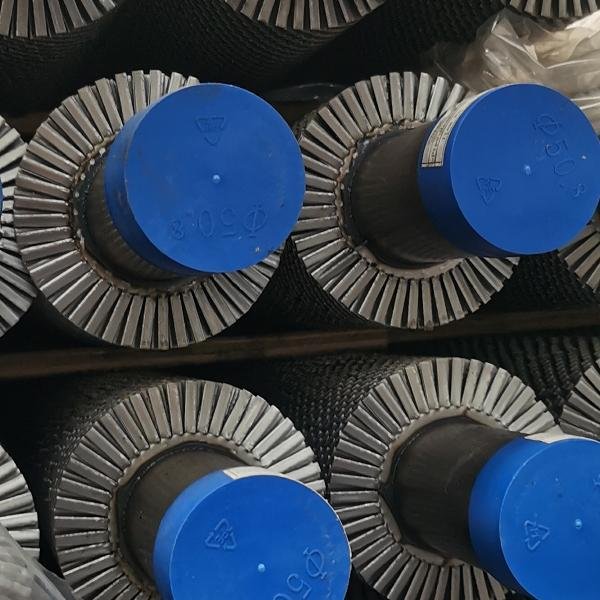Serrated finned tube
Product Description
Product Introduction: Serrated Finned Tube
Overview
The Serrated Finned Tube is an innovative heat exchange solution manufactured using a high-frequency welding process that incorporates patented technology. This advanced method utilizes a high-frequency power supply to simultaneously heat both the steel strip and the steel pipe, allowing them to be welded seamlessly. The resulting product boasts an impressive lifespan, a wide operational temperature range, and exceptional pressure tolerance.
Design & Features
Serrations—small grooves or notches—are strategically cut into the fin surface of the tube. These features are not merely aesthetic; they play a critical role in enhancing thermal efficiency. By disrupting the boundary layer of fluid flow, the serrations increase turbulence, thereby improving convective heat transfer between the tube and the fluid. This design makes the Serrated Finned Tube particularly well-suited for high-performance applications such as boilers, air-cooled condensers, and various heat exchangers.
Manufacturing Process
The manufacturing of Serrated Finned Tubes is characterized by precision and versatility. The high-frequency welding process enables the production of U-bends with longitudinal fins and fin coils upon request. The fins can be tailored in several configurations including one-piece, standard U-bend, cut and twisted, and perforated types. Moreover, customers can specify fin height, number of fins, and fin thickness, making it suitable for various pipe diameters, including Outside Diameter (OD) and Nominal Bore (NB) pipes.
Delivery Conditions
Upon delivery, the Serrated Finned Tubes are square cut at the ends without burrs, and the interior is thoroughly dried and cleaned. The ends of the L-shaped tension wound finned tubes are also coated with varnish for enhanced durability and corrosion resistance.
Acceptance Criteria
The Serrated Finned Tubes comply with API Standard 661, which outlines the requirements for air-cooled heat exchangers deployed in general refinery services. Ensuring adherence to these standards guarantees the quality and reliability of the tubes in demanding environments.
Performance Advantages
-
Efficient Installation: The maximum length of the sawtooth high-frequency welded spiral finned tube can reach up to 16 meters. This reduces the need for multiple connection points, thereby simplifying the installation process and minimizing potential leakage.
-
Low Maintenance: Once installed, these finned tubes are largely maintenance-free, thanks to robust construction and seamless welding.
-
High Efficiency: The full contact welding between fins and steel tubes maximizes the heat dissipation area, with more than eight times the surface area of standard light tubes. This design results in smoother internal surfaces and lower flow resistance.
-
Durability: The finned tubes exhibit high mechanical strength, with a tensile strength exceeding 200 MPa. Additionally, internal and external hot-dip galvanization treatments contribute to a longer service life.
Applications
The Serrated Finned Tube is a wear-resistant, high-efficiency heat exchange material that serves a broad array of sectors. Its applications span waste heat recovery, petrochemical processes, power station boilers, economizers, automotive systems, and both industrial and civil heating and refrigeration systems. Additionally, it finds utility in drying processes for medicinal products, wood, and grains.
Why Choose Serrated Finned Tubes?
The primary advantage of using finned tubes lies in their enhanced heat transfer capabilities. Traditional tubes provide limited surface area, inhibiting efficient heat exchange. Finned tubes, by increasing the external surface area, enable superior heat transfer rates. This design consideration becomes critical when the heat transfer coefficient of the fluid inside the tube is significantly higher than that outside it. For instance, in operations involving heating air or gas, the finned tube system proves invaluable as it dramatically improves the thermal exchange rate.
Industry Standards and Efficiency
According to industry standards, heat exchangers should optimize the transfer of thermal energy efficiently. Key metrics for effective performance include:
-
Temperature Differential: The greater the temperature difference between fluids, the more effective the heat transfer.
-
Heat Transfer Coefficient: Influenced by fluid properties and motion, optimizing this parameter can substantially enhance thermal performance.
-
Surface Area: Increasing the effective surface area, as achieved with finned tubes, directly improves heat transfer efficiency.
Conclusion
In summary, Serrated Finned Tubes represent a paradigm shift in heat exchange technology, providing enhanced operational performance, ease of installation, and low maintenance requirements. Their versatility across various applications, coupled with compliance to rigorous industry standards, makes them a preferred choice for industries seeking efficiency and reliability in thermal management solutions. With continuous improvements and innovations in design and materials, Serrated Finned Tubes are set to play a crucial role in the development of efficient heat exchangers for the future.
Product Image

